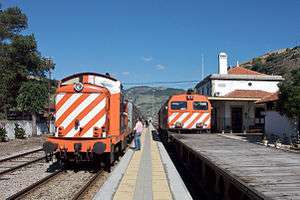Douro railway line

.jpg)

The Douro line (in Portuguese: Linha do Douro) is a railway in northern Portugal. For much of its route the line runs close to the Douro River, offering very scenic views of the river and valley. Trains on the line are operated by Comboios de Portugal (CP).
Construction
| Section between stations | Distance | Date of opening |
|---|---|---|
| Ermesinde – Penafiel | 30.311 km | 29 July 1875 |
| Penafiel – Caíde | 7.328 km | 20 December 1875 |
| Caíde – Juncal | 18.818 km | 15 September 1878 |
| Juncal – Peso da Régua | 38.371 km | 15 July 1879 |
| Peso da Régua – Ferrão | 15.813 km | 4 April 1880 |
| Ferrão – Pinhão | 7.611 km | 1 June 1880 |
| Pinhão – Tua | 12.993 km | 1 September 1883 |
| Tua – Pocinho | 31.678 km | 10 January 1887 |
| Pocinho – Côa | 9.061 km | 5 May 1887 |
| Côa – Barca D’Alva - Spanish border | 18.882 km | 9 December 1887 |
Route
From west to east, the line runs from the junction at Ermesinde to Pocinho. The line formerly continued east for a further 28 kilometres to the Spanish border. Until 1984, the track continued onwards into Spain, thus allowing through trains to/from Salamanca.
Passenger trains normally run from São Bento station in Porto to Pocinho, with some not running as far as the eastern terminus. The line is built to the Iberian gauge of 1,668 mm (5 ft 5 21⁄32 in). The line is single track, apart from a double track section between Ermesinde and Valongo (the authorisation for the dualling work was given by CP in 1993).[1]
In 1984, the Spanish rail operator RENFE announced the closure of its connecting line from La Fuente de San Esteban to the Portuguese border. With the loss of international traffic, CP had to close its line east of Barca d'Alva to Spain. The service was cut back to Pocinho in 1988, which has since remained the eastern terminus of the Douro line.[2]
Branch lines
There were formerly five metre gauge branch lines connecting with the Douro line, but the last of these closed in 2009. Geographically, from west to east they were:
- The Penafiel to Lixa and Entre-os-Rios lines, which closed in the 1920s after less than 20 years of service
- The Tâmega line, which closed in 2009 and ran north from a junction with Douro line at Livração
- The Corgo line, which closed in 2009 and ran north from a junction with Douro line at Regua
- The Tua line, which closed in 2008 and ran north from a junction with Douro line at Tua
- The Sabor line, which closed in 1988 and ran north-east from a junction with Douro line at Pocinho
See also
- CP Class 1400 - diesel locomotives frequently used on the line
- National Railway Museum (Portugal)
- Sorefame - constructor of most of the rolling stock used on the line
References
- ↑ "Cronologia: 1844/1874 - Desde o Projecto até ao Fim do 3º Quartel do Séc. XIX". CP (in Portuguese). Archived from the original on October 6, 2014.
- ↑ "História da linha do Douro". A linha do Douro (in Portuguese). September 1989.
External links
- www.linhadodouro.net (in Portuguese)